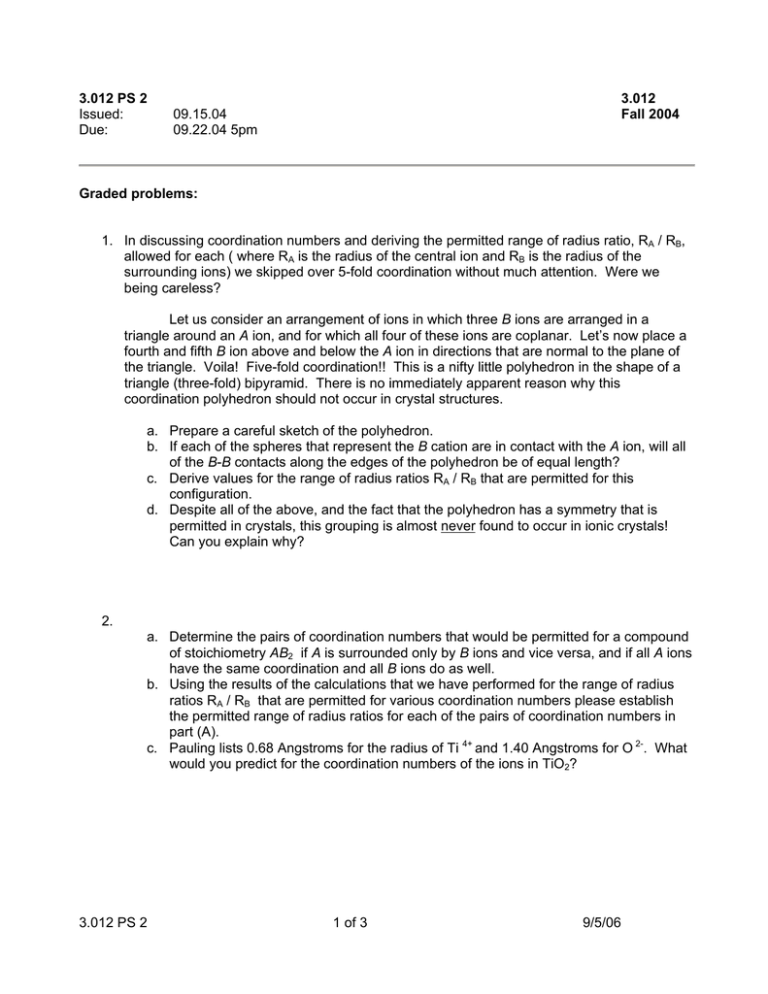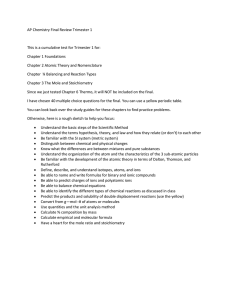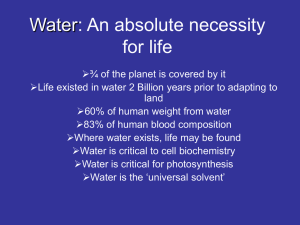3.012 PS 2
advertisement

3.012 PS 2 Issued: Due: 3.012 Fall 2004 09.15.04 09.22.04 5pm Graded problems: 1. In discussing coordination numbers and deriving the permitted range of radius ratio, RA / RB, allowed for each ( where RA is the radius of the central ion and RB is the radius of the surrounding ions) we skipped over 5-fold coordination without much attention. Were we being careless? Let us consider an arrangement of ions in which three B ions are arranged in a triangle around an A ion, and for which all four of these ions are coplanar. Let’s now place a fourth and fifth B ion above and below the A ion in directions that are normal to the plane of the triangle. Voila! Five-fold coordination!! This is a nifty little polyhedron in the shape of a triangle (three-fold) bipyramid. There is no immediately apparent reason why this coordination polyhedron should not occur in crystal structures. a. Prepare a careful sketch of the polyhedron. b. If each of the spheres that represent the B cation are in contact with the A ion, will all of the B-B contacts along the edges of the polyhedron be of equal length? c. Derive values for the range of radius ratios RA / RB that are permitted for this configuration. d. Despite all of the above, and the fact that the polyhedron has a symmetry that is permitted in crystals, this grouping is almost never found to occur in ionic crystals! Can you explain why? 2. a. Determine the pairs of coordination numbers that would be permitted for a compound of stoichiometry AB2 if A is surrounded only by B ions and vice versa, and if all A ions have the same coordination and all B ions do as well. b. Using the results of the calculations that we have performed for the range of radius ratios RA / RB that are permitted for various coordination numbers please establish the permitted range of radius ratios for each of the pairs of coordination numbers in part (A). c. Pauling lists 0.68 Angstroms for the radius of Ti 4+ and 1.40 Angstroms for O 2-. What would you predict for the coordination numbers of the ions in TiO2? 3.012 PS 2 1 of 3 9/5/06 3. Working with the First Law. One mole of an ideal gas is compressed reversibly from 5L to 1 L at a constant pressure of 5 atm, and absorbs 2400 J of heat during this process. a. Calculate the work and internal energy change in this process. b. Determine the initial and final states (P, V, and T) of the gas. c. Now consider a roundabout means of moving the gas from the given initial state to the same final state, as illustrated below. Use a 3-step reversible process, first a constant volume drop in pressure, followed by a constant-pressure compression, followed last by a constant-volume rise in pressure (steps 1, 2, and 3 in the sketch below). i. What is the internal energy change of this composite process (step 1 + step 2 + step 3)? ii. Calculate the total heat transfer and work in this composite process (using P2 as denoted in the diagram below) and use the calculation to prove that heat and work are not state functions. P 5 atm Final state (Pf, Vf, Tf) Initial state (Pi, Vi, Ti) Original process New 3-step composite process (step 3) (step 1) 1 atm (step 2) 1L 3.012 PS 2 5L 2 of 3 V 9/5/06 4. Heat vs. temperature. You are designing a housing for a high-temperature apparatus, which serves to connect this heat-producing generator component to other parts of a larger system. The housing is in thermal contact with the generator (i.e., it can transfer heat with the generator). The generator must operate in cycles: at the start of each cycle, the system starts at a uniform temperature of 577°C, and produces heat. In each cycle, 29.4 kJ of this heat is passed to the housing- after which, the system is allowed to slowly cool back to 577°C (constant pressure conditions throughout). Your design team would like to use aluminum as the housing material as it is lightweight and inexpensive. The housing would be formed from 1 kg of aluminum. Relevant physical data for aluminum is provided below. Tm = 932 K Cps = 20.7 + 12.4x10-3T J/mole K Cpl = 29.0 J/mole K ∆Hm = 10,500 J/mole Do you recommend that aluminum be used in this application? Explain your choice with thermodynamic calculations. 5. Super-cooled Silicon. You have a sample of silicon that is super-cooled to 1670 K from a molten state, and then transferred to an adiabatic container at constant pressure. Calculate: a. The fraction of silicon that solidifies when the melt is placed in the adiabatic container b. the enthalpy change in this process c. the entropy change in this process d. the final temperature of the system at equilibrium Data for Si: Tm = 1683 K ∆Hm = 50,630 J/mole Cps = 22.817 + 0.0038995T – 8.288x10-5T2 – 0.000354063T-2 J/mole K Cpl = 27.19 J/mole K 3.012 PS 2 3 of 3 9/5/06




